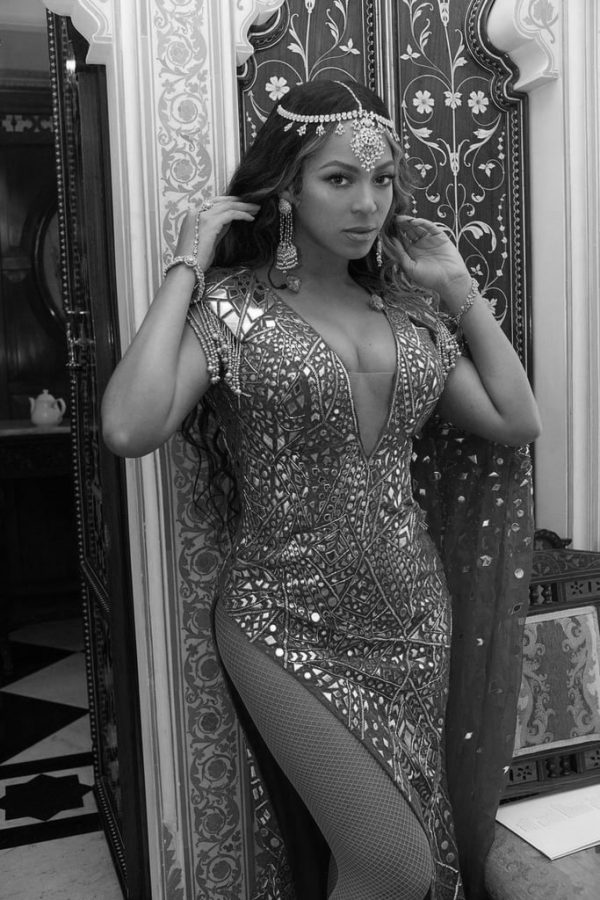Is Beyonce Guilty of Cultural Appropriation?
Beyoncé dressed for the Ambani wedding.
Isha Ambani, the daughter of India’s wealthiest man, married Anand Piramal on December 12, hosting the second-most expensive wedding in history, according to Business Insider and Bloomberg News. Attendees ranged from Bollywood actors to famous politicians, but one figure received global attention for her appearance: Beyoncé. At the wedding, she wore a red-and-gold embellished gown inspired by Indian outfits, which many viewers called “an act of cultural appropriation,” according to the Washington Post. The Cambridge Dictionary defines cultural appropriation as “the adoption of elements from another, often minority, culture without respecting their original meaning or context.” Contrary to such claims, we believe Beyoncé’s performance and apparel proved immensely beneficial to India’s global image, both in the minds of other countries as well as in those of the Indian American youth.
First, Beyoncé’s outfits for her performance were created by Indian designers Falguni Peacock and the reputable firm Khosla Jani, yet critics argue that because her dress did not resemble traditional Indian fashion, it exemplified a misunderstanding of a culture that led to cultural appropriation. However, such accusations fail to account for the fusion of Western and Indian fashion observable in Beyoncé’s gown. Its design incorporated Indian jewelry and sequin patterns based off saris, but the look was completed with fishnet stockings and a plunging neckline. This cultural synthesis denotes that rather than simply electing to wear traditional Indian clothing, Beyoncé attempted, through her choice of attire, to embrace Indian culture while retaining her Western background. Her choice may therefore be perceived as a means of drawing two worlds together without diminishing the cultural values of either one.
Regarding the benefits of Beyoncé’s performance, she garnered an air of reputability and even allure for India. Because “Queen Bey” has amassed so many followers worldwide, the attention of her legions of fans is inevitably directed toward the site of her latest performances. In the case of the Ambani wedding, Beyoncé allowed India to be seen as more than the stereotypical underdeveloped nation, thus presenting its converse and oft-neglected side of buoyant, rich diversity in music, clothing, and festivals.
Furthermore, Beyoncé’s performance encouraged Indian American teenagers to cultivate an appreciation for their heritage. It is increasingly evident that due to their lives in a Western society, many Indian Americans are losing sight of their culture because they are too embarrassed to fully embrace it. Neha Agarwal ’20 cited examples from her childhood of “kids [making] fun of my name or when I wore traditional clothes to school” and remarked that negative stereotyping of Indians “in children’s shows like Ravi in Jesse or Baljit in Phineas and Ferb” reinforced the idea that she should be ashamed of her cultural identity. As for Groton in particular, Maya Varkey ’22 commented that “although I usually do feel comfortable here, I do have times when I feel embarrassed embracing my Indian culture around others.” For Indian-American teens who feel similarly, the appearance of Beyoncé, a world-renowned performer, at the Ambani wedding shows them that their culture is valued.
However, this is not the first time that Beyoncé has been accused of appropriating Indian culture. In a collaboration with Coldplay, Beyoncé was featured in the popular music video for “Hymn for the Weekend,” set in the streets of Mumbai. While music videos do often stretch the bounds of reality, Coldplay and Beyoncé took their representation of India a step too far by depicting the country through an altered Western lens as exotic and psychedelic. Beyoncé’s appearance in the video is a prime example of this: she is featured in front of a kaleidoscope background, heavily bedecked. In several moments, she gestures with her hands in what can only be called a laughable imitation of traditional Indian dance forms.
On the other hand, the video does, albeit in a contrived manner, celebrate other prominent aspects of the country through shots of children jumping gleefully into the Ganges River and people revelling during Holi, a Hindu celebration. Such visuals illustrate the importance of festivals and the natural world in Indian culture, for the Ganges is regarded as sacred, and Holi is celebrated by millions of Hindus each year.
Because Beyoncé profited substantially from her appearances at the Ambani wedding and in Coldplay’s video, many have raised the question of whether her quasi-Indian clothes in both settings indicated that she was appealing to the masses to augment money rather than to exhibit a genuine appreciation for Indian culture. However, we believe that money and appreciation are not mutually exclusive: while a profit may have prompted her decision to perform, it does not negate her attempt to honor Indian tradition through her attire.
Beyoncé’s two appearances at the Ambani wedding and in Coldplay’s video demonstrate that ironically, it is not Indians illustrating their heritage to the Western world but Westerners reveling in Indian culture who ultimately garner praise for the country. This phenomenon encompasses both advantages and drawbacks, for while India may be publicized, it is often misconstrued as well. Beyoncé’s appearance at the Ambani wedding called for worldwide admiration of Indian culture, whereas in Coldplay’s video, Beyoncé contributed to a Westernized misrepresentation of India. Regardless, her efforts were well-intended, and hopefully portrayed the vibrancy and intricacy of Indian culture to many viewers around the world.






